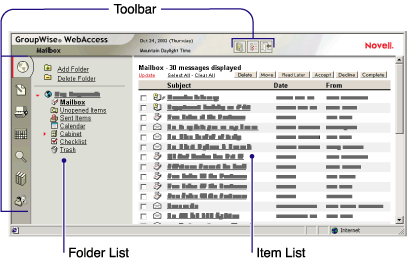Understanding the GroupWise WebAccess Main Window
When you open GroupWise WebAccess, you see the main window, shown below. The main window is the starting point for many of the tasks you can accomplish with GroupWise WebAccess.

The main window has different components to help you accomplish your daily tasks. The following sections describe the various components you can use from the main window:
Understanding the Toolbar
The toolbar displays options to view your Mailbox, compose an item, search the Address Book, view your Calendar, find items in your Mailbox, search for documents in a GroupWise library, proxy to another user, open Help, change your GroupWise WebAccess options, and exit GroupWise WebAccess.
Understanding the Folder List
The Folder List displays the folders used to organize the items you've sent and received. You can add additional folders to further help you organize your items. The Mailbox folder is the default folder that is opened when you first log in.
The following folders are displayed in the Folder List. You can open a folder by clicking the icon.
| Icon | Description |
|---|---|
|
Lists items you've received. The Mailbox is a system folder. |
|
Lists received items you have not yet opened. |
|
Lists items you've sent from the Mailbox and Calendar. The Sent Items folder is a system folder. After you move a sent item from the Sent Items folder to another folder, it no longer displays in the Sent Items folder. (In the previous version of GroupWise WebAccess, the Sent Items folder was a query folder that listed sent items from all folders.) |
|
Lists all appointments, tasks, and notes in your Calendar. The Calendar is a system folder. |
|
Lists items you have moved to this folder. Use the Checklist folder to create a task list. The Checklist folder is a system folder. (In the previous version of GroupWise WebAccess, a Task List folder listed all the task items in your Mailbox and Calendar. The Task List folder was a query folder.) For more information, see Using the Checklist Folder. |
|
Lists folders you've created. The Cabinet is a system folder. |
|
Lists deleted items that have not yet been purged. The Trash is a system folder. |
System folders cannot be deleted.
For additional information about using folders, see Working with Folders.
Personal Folders
You can add additional folders to further organize your items. For example, you could add a folder to your Cabinet to store all messages you receive regarding a specific project you're working on.
Shared Folders
You can share personal folders with other users. Recipients of the shared folder receive a notification explaining that you have shared the folder with them. They can then accept the folder or decline the folder.
Find Results Folders
In the Windows version of GroupWise, you can save the results of an item or document search in a folder. You cannot do this in GroupWise WebAccess. However, GroupWise WebAccess lets you view any Find Results folders you've created in another version of GroupWise.
Understanding the Item List
The Item List displays the contents of the folder that is currently open. By default, the most recent 25 items in the folder are displayed. If the folder contains more than 25 messages, a Display Next button appears at the bottom of the list. You can use it to display the next 25 messages, or you can choose to select more or less than 25 messages.
The icon next to each item indicates the item type, status, and priority. You click an item to open it. When you open an item, all actions you can perform on that item type are displayed at the top of the item view. For easy access, actions that you commonly perform on items are also displayed at the top of the Item List. You can select multiple items by clicking the boxes to the left of the items.
Whenever you select items in the Item List and perform an action on them, WebAccess updates the Item List. However, to reduce the number of times you need to access the Web server, WebAccess does not automatically update the Item List when you open an item and perform an action on it. For example, if you select an item in the Item List and move it to another folder, the Item List will be updated after the move. However, if you open an item and move it to a folder, the Item List is not updated. To refresh the list, you can open the folder again or click Update at the top of the list.
Sent items are bolded to show when they are queued but not delivered, status information has not been received about them being delivered, or they have not yet been transferred to the Internet.
The following icons may be displayed in the Item List:
 Mailbox
Mailbox Unopened Items
Unopened Items Sent Items
Sent Items Calendar
Calendar Checklist
Checklist Cabinet
Cabinet Trash
Trash







































